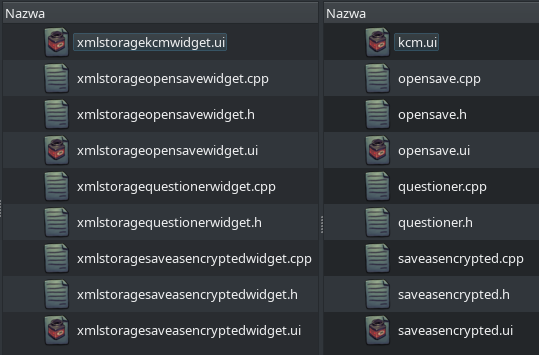Development work described here, has led to multiple modules carrying out the same function. A need has arisen, to name the modules in a way readily discernible to the human eye.
A simplified directory structure (as a tree view) of a storage manager and its two storage plugins is shown below.
.
├── manager
│ └── frontend
│ ├── quick
│ │ └── storagemanageropenquick.h
│ ├── widget
│ │ └── storagemanageropenwidget.h
│ └── storagemanageropen.h
├── sql
│ ├── backend
│ │ └── sqlstoragebackend.h
│ └── frontend
│ ├── quick
│ │ └── sqlstorageopenquick.h
│ ├── widget
│ │ └── sqlstorageopenwidget.h
│ └── sqlstorageopen.h
└── xml
├── backend
│ └── xmlstoragebackend.h
└── frontend
├── quick
│ └── xmlstorageopenquick.h
├── widget
│ └── xmlstorageopenwidget.h
└── xmlstorageopen.h
It can be seen that the file names:
- are relatively long and thus not readily discernible,
- contain repetitive prefixes and suffixes.
Naming convention, used above, is explained below.

The naming convention incorporates all the parts to avoid potential name collisions. It’s used for class names (obligatory) and file names (voluntarily) in the same way. This approach is considered useful in a sense, that it’s easy to find a class name by a file name, and in reverse. This usefulness is limited to short names though.
As a remedy, it has been decided to use namespaces. They have taken prefixes and suffixes, incorporated earlier in class names, on themselves. As a result, classes for opening can be referred by a short Open identifier, as shown below.
namespace Storage {
namespace Xml {
namespace Widget {
Open::method-1();
Open::method-2();
...
Open::method-n();
}
}
}
namespace Storage {
namespace Sql {
namespace Widget {
Open::method-1();
Open::method-2();
...
Open::method-n();
}
}
}
Instead by a full identifier only, as shown below.
XmlStorageOpenWidget::method-1();
XmlStorageOpenWidget::method-2();
...
XmlStorageOpenWidget::method-n();
SqlStorageOpenWidget::method-1();
SqlStorageOpenWidget::method-2();
...
SqlStorageOpenWidget::method-n();
Content of xml/frontend/widget directory from the application’s code, before and after applying namespaces, is shown below for comparison.

As one can see, the content on the right side is more readily discernible.
As for the numbers:
- 122 from 186 files in the storage manager benefit from this design;
- 17 unique names have been reused instead of prefixed, or suffixed for uniqueness.